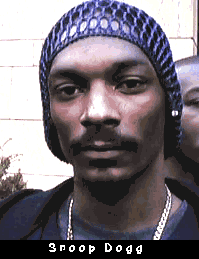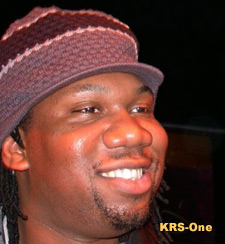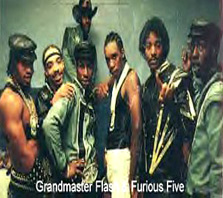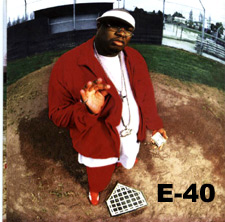
The Weekly Hip-Hop Word# 1
December 8 1995:
Hip Hop Vs Rap...The East/West Coast Battleby Dave 'Davey D' Cook
The general consensus has been that west coast artists are not 'hip hop' while everyone on the east coast is true to the game and true to the culture. In short, the East Coast is responsible for'keeping it real' while the west coast is responsible for contaminating the culture with 'gangsta rap'. There are experts within the field who literally scorn artist like Snoop Dog, Well, let's put things in its historical context. To start, hip hop has always been defined as the culture from where rap emerged. Within hip hop there were four main areas that help shape the culture: graffiti art, breakdancing, djaying and rapping. One did not have to be a rap star to be a part of hip hop. In fact, rap was the last element to really emerge within hip hop. But because breakdancing and graffiti aren't in the mainstream as much as rap, people often use terms hip hop and rap interchangeably. A point of information on the historical tip, shows that the term hip hop was coined by DJ Hollywood who used to scat when rhyming. The word hip hop was taken from him saying rhymes like 'hip hop she bop a dop hip hip hop and ya don't stop'. The term rap had been around in the African American community for generations. In each era it described a particular form of verbal persuasiveness. During the hip hop's infancy in the mid 70s, the term 'rap' was used to describe the set of arguments used by a young man to convince a young woman to grant him sexual favors. That, of course, derived from the love raps that were made famous by R&B artists like Barry White and Millie Jackson where they did more talking than rhyming. The word used to describe the act of rhyming to beat of music was called initially called 'emceeing'. The word rap began to replace this term after the release of Sugar Hill Gang's record Rappers Delight.
With regards to hip hop culture, one has to closely examine the political, social, and economic conditions that were in place during the mid 70s in New York City and what sort of effect they were having on the young African American and Puerto Rican males who eventually laid down the foundation for hip hop. For many young people there was a sense that NY's power structure
and older generation was attempting to shut down their voices. The police were cracking down hard on young men under the guise of trying to rid NY of its notorious gangs. Institutions like Black music radio that were once mainstays in the lives of New York's black and brown population were no longer languaging themselves toward these young folks. Author Nelson Georgepoints this out in his book,
This notion of hip hop selling out if they do things for money is nonsense. In the late 70's, if folks knew they could make money off of rhyming they would've definitely went for the gusto. Today, 'experts' scoff at 'rap' artists who make calculated 'marketing' moves to net money, while not realizing that hip hop's pioneers like Grandmaster Flash, Bambaataa, GrandWizard Theodore For example, artists rolled through parties with the finest gear, i.e. expensive sheep skin coats, puma sneakers, and certain types of jewelry. Many liked to be seen cruising the town in OJs which were fancy chauffer-driven luxury cars with booming sytems. The early rap artists put forth the image money was being made at the events in which they particpated. The way financial acquistion has distorted hip hop culture has been primarily through those who have not participated in the architecting of this culture, but have offered their purse strings to hungry artist who were trying to get ahead. What has been unfortunate is that those holding the purse strings have insisted on certain types of formulas and imagery being put forth based upon their own understanding of what will net financial success. It has become confusing for many to determine whether or not an artist like Snoop Dogg who puts forth gangster imagery was doing so for himself or to satisfy the desires of his record company. Complicating this situation even further has been some of the purse string holders positioning themselves as definers of hip hop culture. Unfortunately their definition has been offbase. For example, 'Experts' have been critical of artists who don't 'freestyle', use refrains in their songs, incorporate vocal harmonies or rehearse their rhymes. Contrary to popular belief, most of hip hop's pioneers like Melle Mel or Grandmaster Caz did all of the above. They practiced their routines for hours, harmonized like r&b group Boyz II Men and, as Melle Mel recently noted, 'kept a set of battle rhymes in their back pocket'. GMF member Kid Creolespoke about how he employed a refrain like 'yes, yes, y'all' which allowed him not only to break up his rhyme flow, but also to allow him some breathing space to think of some more rhymes. Many early emcees employed such techniques. A typical refrain went as follows, 'Yes, yes, y'all, ya don't stop. Keep on 'till the break dawn. Yes, yes, y'all ya don't quit. Keep on, 'cause I'm the serious shit'. 'The name of the game was your ability to execute your craft,' rap pioneer Melle Mel noted in a recent interview. He added, that back in the days, if you weren't entertaining or you were a lousy performer you got dissed. Today's rhyme sayers don't put as much work in their routines as they do their recordings and marketing campaigns. After all, in '95 it is on this level where they get paid. Ice Cube's trade mark scowl, Too Short's 'Shorty The Pimp image', LL Cool J's 'love man' image, Ice T's 'High Roller' image are all calculated marketing moves designed to be bigger then life. This is not to say some of those images don't reflect their personalities. A smart artist understands that people die while images live on. After all, in today's entertainment arena where videos and tv set the tone for public opinion, a successful rap artist finds his/her niche and crafts an image around it. Now some folks will say this is fake and it is not hip hop. But it most certainly is. What once worked in '78 does not necessarily apply in '95 so adjustments have to be made in the way material is presented.
True hip hop always accurately reflects the sentiments and language of a
targeted audience. In '78 the kid from the Bronx, in order to impress all of
NYC, had to have lyrical finesse and a tight routine. In '95 an artists from
Vallejo may have to rap about his neighborhood and put forth a certain image
which not only gets him respect but also gets him paid. Getting paid is part
of that criteria to net success within some hip hop circles. The beauty of
hip hop is that it's a hodge-podge of many things that is constantly
evolving. It is diverse so KRS-One, The Beastie Boys, E-40,
|
6657 Broadway East,
Vancouver, BC
V5B 2Y6 CANADA
Tel: (604)878-0224 Fax: (604)444-4544
 E-40 or Ice Cube who've sold millions of records and have had some sort of financial success. They claim that hip hop is not about money
and that financial success is proof that such artists have turned their back on the culture. They'll compare an artist like Snoop to KRS-One and will insist that KRS-One's microphone prowess deems him hip hop while Snoop is rap. Bear in mind this subjective determination rarely takes into account the opinions and sentiments of west coast fans. To view hip hop from an east
coast perspective means that songs that talk about guns, gats, drivebys,
'playas' and 'bitches' is a perversion of the music and culture. It doesn't promote the positively that hip hop has always been about.
E-40 or Ice Cube who've sold millions of records and have had some sort of financial success. They claim that hip hop is not about money
and that financial success is proof that such artists have turned their back on the culture. They'll compare an artist like Snoop to KRS-One and will insist that KRS-One's microphone prowess deems him hip hop while Snoop is rap. Bear in mind this subjective determination rarely takes into account the opinions and sentiments of west coast fans. To view hip hop from an east
coast perspective means that songs that talk about guns, gats, drivebys,
'playas' and 'bitches' is a perversion of the music and culture. It doesn't promote the positively that hip hop has always been about. The Death of Rhythm and Blues. The music itself
was changing as diluted, formulated forms of disco begain to fill the
airwaves replacing the rich urban soul and funk tunes that were the flavors of the day. Afrika Bambaataa often speaks about how during this time period how NYC lost its 'funk'. Fueling this sense of abandonment was a perception that Blacks and Puerto Ricans while being increasingly criminalized, were being replaced by white pop icons in their urban landscape.White rock artists ranging from Elton John to Mick Jagger boomed on Black airwaves
doing discotunes and John Travolta with his dance performance in Saturday Night Fever became the new standard bearer and toast of the town. Hip hop
was a rebellion to all of this. It was essentially the way in which young people (whose viewpoints were being obscured) expressed themselves, demanding to be seen and heard. During that time being skilled at one's craft in grafitti, breakdancing, deejaying or emceeing was the name of the game as everyone strived to find a niche that would get them 'props' [accolades] from their peers. Obtaining money was never an issue for the early hip hop artists because the possibilities of making money for rhyming or break dancing was unthinkable at that time.
The Death of Rhythm and Blues. The music itself
was changing as diluted, formulated forms of disco begain to fill the
airwaves replacing the rich urban soul and funk tunes that were the flavors of the day. Afrika Bambaataa often speaks about how during this time period how NYC lost its 'funk'. Fueling this sense of abandonment was a perception that Blacks and Puerto Ricans while being increasingly criminalized, were being replaced by white pop icons in their urban landscape.White rock artists ranging from Elton John to Mick Jagger boomed on Black airwaves
doing discotunes and John Travolta with his dance performance in Saturday Night Fever became the new standard bearer and toast of the town. Hip hop
was a rebellion to all of this. It was essentially the way in which young people (whose viewpoints were being obscured) expressed themselves, demanding to be seen and heard. During that time being skilled at one's craft in grafitti, breakdancing, deejaying or emceeing was the name of the game as everyone strived to find a niche that would get them 'props' [accolades] from their peers. Obtaining money was never an issue for the early hip hop artists because the possibilities of making money for rhyming or break dancing was unthinkable at that time. made calculated 'marketing' moves to get props and draw crowds at their functions. Hence, today's artist who raps about gats and guns while wearing khakis and locs are no different than pioneers like Grandmaster Flash who adorned fancy colorful leather outfits, executed synchronized dance routines and harmonized their raps. It's just in '95, the
payment is dead presidents [dollar bills] and not pats on the back.
Hip hop has always been about money in the sense that if hip hop's pioneers
had the knowledge and resources that today's rap artist have, they too
would've went down the path to obtain some riches. Back in the late 70's,
hip hop artists were not in a position to put out records, although many
artists would've loved to have recorded them. In lieu of that, many of hip
hop's early architects made very calculated, well-rehearsed moves that not
only resulted in their revered status but also symbolized economic success.
made calculated 'marketing' moves to get props and draw crowds at their functions. Hence, today's artist who raps about gats and guns while wearing khakis and locs are no different than pioneers like Grandmaster Flash who adorned fancy colorful leather outfits, executed synchronized dance routines and harmonized their raps. It's just in '95, the
payment is dead presidents [dollar bills] and not pats on the back.
Hip hop has always been about money in the sense that if hip hop's pioneers
had the knowledge and resources that today's rap artist have, they too
would've went down the path to obtain some riches. Back in the late 70's,
hip hop artists were not in a position to put out records, although many
artists would've loved to have recorded them. In lieu of that, many of hip
hop's early architects made very calculated, well-rehearsed moves that not
only resulted in their revered status but also symbolized economic success. and Luke are all hip hop. They just all take a different approach to achieving their aim: respect from peers and cash flow for their efforts. So with this in mind, of course the hip hop coming out of New York is different than the hip hop coming out of California. And while there are artists like Souls Of Mischief
or Pharcyde who may have more an East Coast flava who hail from the west, it
does not mean they are any more hip hop than Mack 10 or JT The Bigga Figga whose styles have a more West Coast appeal. In fact, by the strict
definition of hip hop, a rhyme style that derives from the AFRICAN ORAL
TRADITION and a culture of self expression that appeals to those living in
oppressed conditions (the music which is enormously popular amongst the
youth of Cali's ghettos) may in fact be considered more hip hop when
compared to the music that doesn't. Groups like Souls or The BUMS, while
having great lyrical skillz that are respected by NY's hip hop audience,
unfortunately take a back seat to many of the lesser skilled artist from
around their way. Nevertheless, in my book they're all part of the same
family primarily because African Americans are all part of the same family.
Again the approach the BUMS or Souls have toward expressing hip hop reflects
the diversity of the music. They have East Coast flava in a West Coast
environment. They are adding to the pie.
and Luke are all hip hop. They just all take a different approach to achieving their aim: respect from peers and cash flow for their efforts. So with this in mind, of course the hip hop coming out of New York is different than the hip hop coming out of California. And while there are artists like Souls Of Mischief
or Pharcyde who may have more an East Coast flava who hail from the west, it
does not mean they are any more hip hop than Mack 10 or JT The Bigga Figga whose styles have a more West Coast appeal. In fact, by the strict
definition of hip hop, a rhyme style that derives from the AFRICAN ORAL
TRADITION and a culture of self expression that appeals to those living in
oppressed conditions (the music which is enormously popular amongst the
youth of Cali's ghettos) may in fact be considered more hip hop when
compared to the music that doesn't. Groups like Souls or The BUMS, while
having great lyrical skillz that are respected by NY's hip hop audience,
unfortunately take a back seat to many of the lesser skilled artist from
around their way. Nevertheless, in my book they're all part of the same
family primarily because African Americans are all part of the same family.
Again the approach the BUMS or Souls have toward expressing hip hop reflects
the diversity of the music. They have East Coast flava in a West Coast
environment. They are adding to the pie.